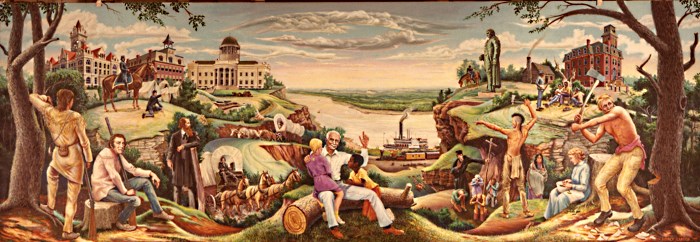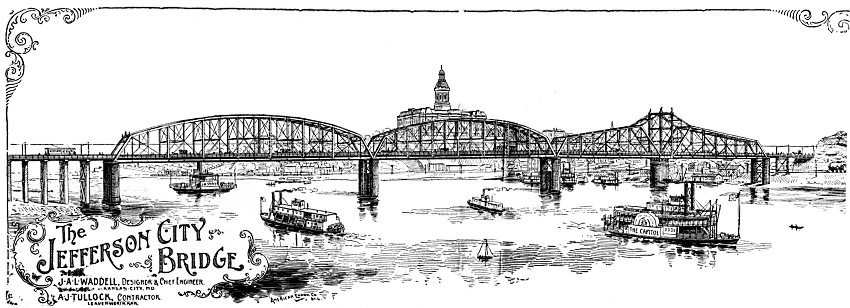
|
 |
Old Bridge at Jefferson City |
History of the Bridge at Jefferson City
Articles from State Republican newspaper regarding "Dedication" of the bridge at Jefferson City
The Following Historical Sketch is Taken From the Tribune of This City, May 23, 1895.
By an examination of an old map of the City of Jefferson, made about the year 1873, by Charles V. Buck, who was at that time City Engineer, it will be seen that in these early days the people of Jefferson City were discussing the possibility of the construction of a bridge across the Missouri River on Bolivar Street. The map shows the site and has the tracings of a bridge across the river. At that time, such a structure as is now about to be built and under contract, would have cost, at the very lowest estimate, $800,000. Since that time, several efforts have been made to induce the Chicago & Alton Railroad Company to construct a bridge, but without effect. The matter rested in that condition until the tenth day of April, 1893.
On the evening of that day, a large gathering of citizens, about one hundred, who had met for the purpose of electing officers of the Commercial Club, that had been recently organized, J.C. Fisher, of this city, made a speech calling attention to the great advantages that would accrue to this city by the construction of an electric road and wagon bridge across the river, stating at the time, that the cost would probably be $300,000.
This address was heartily applauded and from that time to this the people of this city have been talking bridge. Shortly after the meeting above referred to, a proposition was submitted by an Eastern company to construct a bridge at this place for a bonus of $50,000. Mayor Grimshaw appointed a soliciting committee consisting of fifteen of the most prominent citizens to ascertain whether this money could be raised. That committee consisted of the following persons: J.C. Fisher, chairman; F.H. Binder; Henry J. Dulle; Phillip Ott; A. Brandenberger; Henry W. Ewing; R. Dallmeyer; Hugo Monnig; J.W. Henry; Ben Veith; L.D. Gordon; W.F. Rousin; W.W. Wagner and Dr. J.P. Porth.
This committee immediately commenced the work of soliciting subscriptions and by the 28th of June had secured $48,000. Up to this time no charter had been secured from congress authorizing the constructing of a bridge at that time. After this bonus had been secured, a meeting of the Commercial Club was called for the purpose of determining the best policy to be pursued under the circumstances. It was decided at that meeting that a company with a capital stock of $2,000 be organized for the purpose of making soundings of the river and plans of a high bridge that the people might know just what the cost of such a structure would be. A committee of three was appointed to visit every member of the club for the purpose of securing stock subscriptions to the amount of $2,000 for the purposes indicated. When this stock was subscribed, the company was organized and a charter secured from the Secretary of State. Mr. J.A.L. Waddell, an eminent bridge engineer, who was especially familiar with bridge building on the Missouri River, was invited to come before the board and was employed to make the soundings of the river and plans for a high bridge. Mr. Waddell was assisted in making the borings by Mr. Alexander H. Webber of this city.
After the soundings were made and the plans for a high and low bridge and a report made to the company as to the cost of such structure, was at once decided that congress be asked for a charter authorizing tho construction of either a high or low bridge. This charter was drawn up in February, 1804, and sent to Senator Vest and congressman Bland. Owing to the opposition of the Missouri river Commission against tho granting of low bridge charter, th company failed to secure such, but were granted the privilege of building a high bridge.
The engineer of the company, Mr. J.A.I. Waddell, having made plans for both a high and low bridge, was sent to New York, Chicago and other eastern cities for the purpose of securing the very best possible bid that could be secured for the construction of high bridge. The four bids as made by competitors, were presented to the board of directors of the Jefferson City Bridge & Transit Company, consisting of: F.H. Binder, H. W. Ewing, Henry J. Dulle, J.W. Henry, J.C. Fisher, H.F. Priest , J.P. Porth, Hugo Monnig, R. Dahlmeyer, W.W. Wagner and A.P. Grimshaw.
The proposition of Mr. A.J. Tullock, proprietor of the Missouri Valley Bridge & Iron Works, was found to be the best and most accented up on the condition that final contract should be awarded and the money be raised. After this charter was secured, the company located the bridge on Madison Street, a natural site for a high bridge; but upon a careful investigation, it was found that the cost of the high bridge was $30,000 more than the low bridge and annual expense of keeping up $50,000 more, and the company soon became convinced that it was impossible to build such a bridge. The prospects for a bridge had become very gloomy and the company was about ready to throw up the sponge and surrender all hope accuring a bridge, as under the charter they had no authority to construct a low bridge, and the funds for the high bridge could not be secured in view of the fact that the income would not justify the expenditure of the amount necessary to build it, and the cost of maintaining it. With the outlook gloomy, and every prospect of securing a low bridge charter very dismal and uncertain, J.C. Fisher concluded that he would make a trip to Washington and make the last final effort and struggle for a low bridge charter. He feft the city on the 10th day of December for Washington, with document, plans of bridge and other letters, directed to the Hon. Daniel Lamont, Secretary of War, and succeeded in securing consent for a low bridge.
On the nineteenth day of December, Senator Vest secured the consent of the committee on commerce for the favorable report of an amendment to the charter authorizing the construction of a low bridge at Jefferson City and made his report to the Senate and secured the passage of the amendment.
Before Christmas, Congressman Bland had put the measure through the House and on the fifth day of January, 1895, it received the signature of Grover Cleveland, President of the United States, upon the recommendation of General Casey, the Chief Engineer of the War Department.
After the approval of this charter authorizing the construction of a draw bridge across the Missouri River at Jefferson City, the weather being so cold, it was practically impossible for anything to be accomplished in the way of soliciting stock subscriptions, but the company was making every effort to that end, when suddenly and without warning, the bridge company and Jefferson City were confronted with the capital removal scheme. For a few weeks, it looked very much as if it would be impossible to resurrect the bridge, but notwithstanding the effort of Sedalia to bear Jefferson City, the following gentlemen of the old soliciting committee concluded, that they would shoulder the labor of securing over $100,000 in cash for the purpose of securing this bridge. These persons were: J.C. Fisher, L.D. Gordon, W.F. Roesin, and Dr. J.P. Porth. They commenced their labors about the 22nd of March and by the 15th day of May had secured over $104,000. Before the committee resumed work, the bridge committee called their engineer and contractor for a conference and secured a modified proposition to build a draw bridge under the amended charter on Bolivar Street. The cost of this bridge, in round numbers, is about $200,000. After the modified proposition had been made the same was duly accepted by the company under an agreement that the contract must be finally closed before the first day of June. After the soliciting committee found that they were practically certain of raising the amount the engineer and contractor were called before the bridge company on Tuesday and Wednesday (May 14 and 15), and all plans and specifications and contract were submitted by the engineer, J.A.L. Waddell and thoroughly examined by the board of directors. Gen. H. Clay Ewing, Mayor Silver and Mr. J.R. Edwards were invited to assist the board in making the final contract and on Wednesday evening at 10:30 p.m. May 15, the contract for a draw bridge on Bolivar Street was duly entered into by and between the Jefferson City Bridge & Transit Co. through its Pres. F.H. Binder, attested by J.P. Porth, sec. and A.J. Tullock, proprietor of the Missouri Valley Bridge & Iron Works of Leavenworth, Kans. Under the contract, this bridge is to be completed on or before the first day of March, 1896.
[Ed. Note] Were the contractors ready to begin immediate construction of the bridge? Absolutely not. The groundbreaking ceremony was necessary to meet the provision for commencing construction before May 28, 1865. From the construction photos which were taken to document the progress of the construction we see that the very first activity documented on photo #01 was on July 30, 1895, which shows a start on the #2 caisson, which would be used in the construction of the pier which supported the rotating swing span. That construction start was approximately sixty-seven days after the groundbreaking ceremony and sixty days after the expiration of the charter.
The following is a description of the bridge:
The bridge is located at the foot of Bolivar Street, Jefferson City, Missouri and across the river angles to the current. From the retaining wall in the street to high waters' edge, the structure will be a trestle about 140 feet long across the Missouri Pacific Railway track with a clearance of 21 feet above base rail. This trestle will consist of steel towers and cross girders with a wooden floor and wrought iron hand rail. The first span from the Jefferson City shore, will be a draw span of 440 feet between centers of end pins. Following which will be two clear spans of 350 feet each between centers of end pins; then a pile trestle of about 465 feet long and finally a protective earth embankment about 1300 feet long. The clear road way of the bridge is to be 20 feet making the distance between center spans of trestle 22 feet; the clear head way will be something less than 15 feet. The hand rails are to be of wood strong and high and thoroughly braced so as to prevent accidents.
At the bottom of each hand rail there is to be a wheel guard of timber to prevent vehicles from striking the hand rail or superstructure. The floor is to be of long leaf southern yellow pine.
The bridge is constructed for the carrying of motor and street cars, wagons etc. The present officers of the Jefferson City Bridge and Transit Company are: F.H. Binder, President; J.P. Porth, Secretary; J.W. Henry, Treasurer; and Miss Edith Rhodes assistant Secretary. The authorized capital stock is $200,000 and the amount subscribed $104,250.
Photo Review of the Old Bridge
Video History of Jefferson City's Old Bridge
Video Construction of Jefferson City's Old Bridge
Description of Bridge Construction Images
Timeline of Bridge Construction

